Indoor Radon Measurements Using Radon Track Detectors and Electret Ionization Chambers in the Bauxite-Bearing Areas of Southern Adamawa, Cameroon
Abstract
1. Introduction
2. Materials and Methods
2.1. Study Areas
2.2. Methodology
2.2.1. Electret Ionization Chamber
2.2.2. Closed Alpha-Track Detector (RADTRAK²®)
2.2.3. Inhalation Dose
2.2.4. External Effective Dose
3. Results and Discussion
3.1. Indoor Radon Distribution Using Electret Ionization Chambers (EPERM)
3.2. Indoor Radon Distribution Using Radon Track Detectors (RADTRAK)
3.3. Comparison of the Results Obtained with EPERM and RADTRAK
3.4. External Effective Dose
3.5. Inhalation Dose
4. Conclusions
Author Contributions
Funding
Acknowledgments
Conflicts of Interest
References
- Mining Code. Cameroon Law No. 2016/017. 14 December 2016. Available online: https://www.prc.cm/fr/actualites/actes/lois/2316-loi-n-2016-017-du-14-decembre-2016-portant-code-minier-du-cameroun?highlight=WyJjb2RlIiwibWluaWVyIiwiY29kZSBtaW5pZXIiXQ== (accessed on 4 July 2020).
- Capacity Building Project in the Mining Sector. Available online: https://min-midtgov.com/precasem/ (accessed on 4 July 2020).
- Kovacs, T.; Bátor, G.; Schroeyers, W.; Labrincha, J.; Puertas, F.; Hegedus, M.; Nicolaides, D.; Sanjuán, M.; Krivenko, P.; Grubeša, I.; et al. From raw materials to NORM by-products. Nat. Occur. Radioact. Mater. Constr. 2017, 2017, 135–182. [Google Scholar] [CrossRef]
- Hegedűs, M.; Tóth-Bodrogi, E.; Jónás, J.; Somlai, J.; Kovács, T. Mobility of 232 Th and 210 Po in red mud. J. Environ. Radioact. 2018, 185, 71–76. [Google Scholar] [CrossRef] [PubMed]
- Bauxite. Available online: https://www.aluminum.org/industries/production/bauxite (accessed on 7 July 2020).
- Saïdou; Abdourahimi; Siaka, Y.T.; Bouba, O. Indoor radon measurements in the uranium regions of Poli and Lolodorf, Cameroon. J. Environ. Radioact. 2014, 136, 36–40. [Google Scholar] [CrossRef]
- Saïdou; Tokonami, S.; Janik, M.; Bineng Guillaume, S.; Abdourahimi; Ndjana Nkoulou, J.E., II. Radon-thoron discriminative measurements in the high natural radiation areas of southwestern Cameroon. J. Environ. Radioact. 2015, 150, 242–246. [Google Scholar] [CrossRef]
- Saïdou; Abiama, P.E.; Tokonami, S. Comparative study of natural radiation exposure to the public in three uranium and oil regions of Cameroon. Radioprotion 2015, 50, 265–271. [Google Scholar] [CrossRef]
- Ndjana Nkoulou, J.E., II; Ngoa Engola, L.; Hosoda, M.; Bongue, D.; Suzuki, T.; Kudo, H.; Kwato Njock, M.G.; Tokonami, S. Simultaneous indoor radon, thoron and thoron progeny measurements in betare-oya gold mining areas, eastern cameroon. Radiat. Prot. Dosim. 2019, 185, 391–401. [Google Scholar] [CrossRef]
- Saïdou; Tokonami, S.; Hosoda, M.; Ndjana Nkoulou, J.E., II; Akata, N.; Tchuente Siaka, Y.F.; Modibo, O.B.; Samuel, B.G.; Takoukam Soh, S.D. Natural radiation exposure to the public in mining and ore bearing regions of cameroon. Radiat. Prot. Dosim. 2019, 184, 391–396. [Google Scholar] [CrossRef]
- Takoukam Soh, S.D.; Tokonami, S.; Hosoda, M.; Suzuki, T.; Kudo, H.; Bouba, O.; Saïdou. Simultaneous measurements of indoor radon and thoron and inhalation dose assessment in Douala City, Cameroon. Isot. Environ. Heal. Stud. 2019, 55, 499–510. [Google Scholar] [CrossRef] [PubMed]
- Saïdou; Shinji, T.; Hosoda, M.; Tchuente Siaka, Y.F.; Ndjana Nkoulou, J.E., II; Naofumi, A.; Oumar Bobbo, M.; Penaye Joseph. Natural radiation exposure to the public in the uranium bearing region of Poli, Cameroon: From radioactivity measurements to external and inhalation dose assessment. J. Geochem. Explor. 2019, 205, 106350. [Google Scholar] [CrossRef]
- Oumar Bobbo, M.; Saïdou; Ndjana Nkoulou, J.E., II; Suzuki, T.; Kudo, H.; Hosoda, M.; Owono, L.C.O.; Tokonami, S. Occupational Natural Radiation Exposure at the Uranium Deposit of Kitongo, Cameroon. Radioisotopes 2019, 68, 621–630. [Google Scholar] [CrossRef]
- Bineng, G.S.; Saïdou; Hosoda, M.; Tchuente Siaka, Y.F.; Akata, N.; Ele Abiama, P.; Bouba, O.; Tokonami, S. External radiation exposure to the public using car-borne survey method in the uranium and thorium bearing region of Lolodorf, Cameroon. Radiat. Environ. Med. 2020, 9, 13–20. [Google Scholar]
- Bineng, G.S.; Tokonami, S.; Hosoda, M.; Tchuente Siaka, Y.F.; Issa, H.; Suzuki, T.; Kudo, H.; Bouba, O.; Saïdou. The Importance of Direct Progeny Measurements for Correct Estimation of Effective Dose Due to Radon and Thoron. Front. Public Heal. 2020, 8, 17. [Google Scholar] [CrossRef] [PubMed]
- CAL, Cameroon Alumina Limited, Etude d’Impact Environnemental et Social du Projet d’Exploitation des Gisements de Bauxite de Minim-Martap et Ngaoundal dans la Région de l’Adamaoua, République du Cameroun; India and Rainbow Environment Consulting: Yaoundé, Cameroon, 2010. (In French)
- Canyon Resources Limited. [Internet]. Available online: https://www.canyonresources.com.au/minim-martap-project (accessed on 3 May 2020).
- Canyon Resources Limited. Company Announcement. 6 August 2019. Available online: https://static1.squarespace.com/static/5b9cbcb58f5130f854d93dad/t/5de0bd0bd36d6241f15842d3/1575009553272/190927+Significant+Resource+upgrade+at+Minim+Martap.pdf (accessed on 3 May 2020).
- Kotrappa, P.; Stieff, L.R.; Bigu, J. E-PERM Radon Flux Monitors for Measuring Undisturbed Radon Flux from the Ground. In Proceedings of the 1996 International Radon Symposium II. Available online: http://aarst-nrpp.com/proceedings/1996/1996_13_Passive_E_Perm_Radon_Flux_Monitors_For_Measuring_Und.pdf. (accessed on 3 May 2020).
- ISO 11665-4, Measurement of Radioactivity in the Environment—Air: Radon-222, Part 4: Integrated Measurement Method for Determining Average Activity Concentration Using Passive Sampling and Delayed Analysis (2020). Available online: https://www.iso.org/standard/76009.html (accessed on 3 May 2020).
- United Nations Scientific Committee on the Effects of Atomic Radiation (UNSCEAR). Sources and Effects of Ionizing Radiation; United Nations Publication: Vienna, Austria, 2000. [Google Scholar]
- International Commission on Radiological Protection (ICRP). Lung Cancer Risk from Radon and Progeny and Statement on Radon; ICRP Publication 115, Part 1; Pergamon Press: Oxford, UK, 2010. [Google Scholar]
- International Commission on Radiological Protection (ICRP). Occupational intakes of radionuclides: Part 3; ICRP Publication 137; Pergamon Press: Oxford, UK, 2017. [Google Scholar]
- United Nations Scientific Committee on the Effects of Atomic Radiation (UNSCEAR). Report of the UNSCEAR to 66th General Assembly of the United Nations; United Nations Publication: Vienna, Austria, 2019. [Google Scholar]
- Janik, M.; Omori, Y.; Yonehara, H. Influence of humidity on radon and thoron exhalation rates from building materials. Appl. Radiat. Isot. 2015, 95, 102–107. [Google Scholar] [CrossRef] [PubMed]
- Nazaroff, W.W. Radon transport from soil to air. Rev. Geophys. 1992, 30, 137. [Google Scholar] [CrossRef]
- Gusain, G.; Prasad, G.; Prasad, Y.; Ramola, R.C. Comparison of indoor radon level with radon exhalation rate from soil in Garhwal Himalaya. Radiat. Meas. 2009, 44, 1032–1035. [Google Scholar] [CrossRef]
- Andersen, C.E. Numerical modelling of radon-222 entry into houses: An outline of techniques and results. Sci. Total. Environ. 2001, 272, 33–42. [Google Scholar] [CrossRef]
- International Commission on Radiological Protection (ICRP). Radiological Protection against Radon Exposure, ICRP Publication 126; Pergamon Press: Oxford, UK, 2014. [Google Scholar]
- WHO, World Health Organization. WHO Handbook on Indoor Radon, a Public Health Perspective; WHO Press: Geneva, Switzerland, 2009. [Google Scholar]
- Iida, T.; Ikebe, Y.; Suzuki, K.; Ueno, K.; Wang, Z.; Jin, Y. Continuous measurements of outdoor radon concentrations at various locations in East Asia. Environ. Int. 1996, 22, 139–147. [Google Scholar] [CrossRef]
- Sorimachi, A.; Takahashi, H.; Tokonami, S. Influence of the presence of humidity, ambient aerosols and thoron on the detection responses of electret radon monitors. Radiat. Meas. 2009, 44, 111–115. [Google Scholar] [CrossRef]
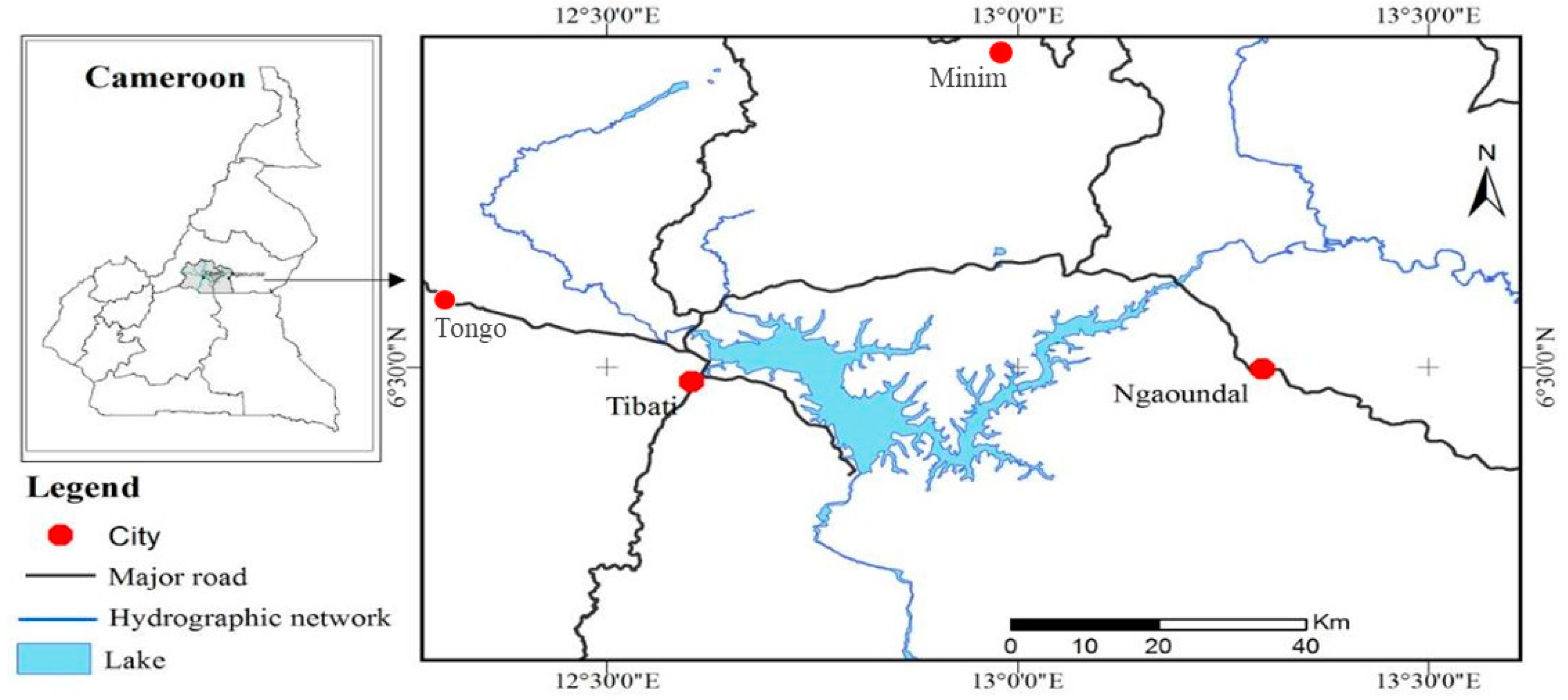
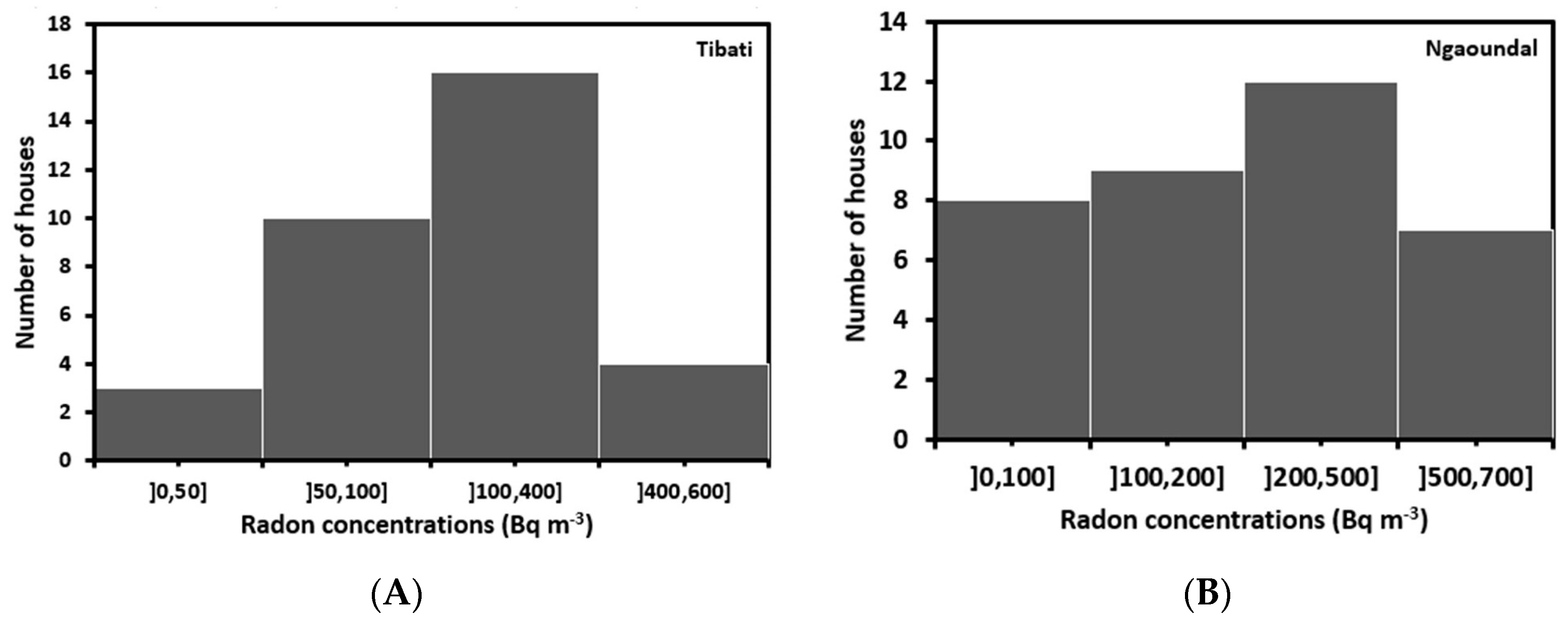

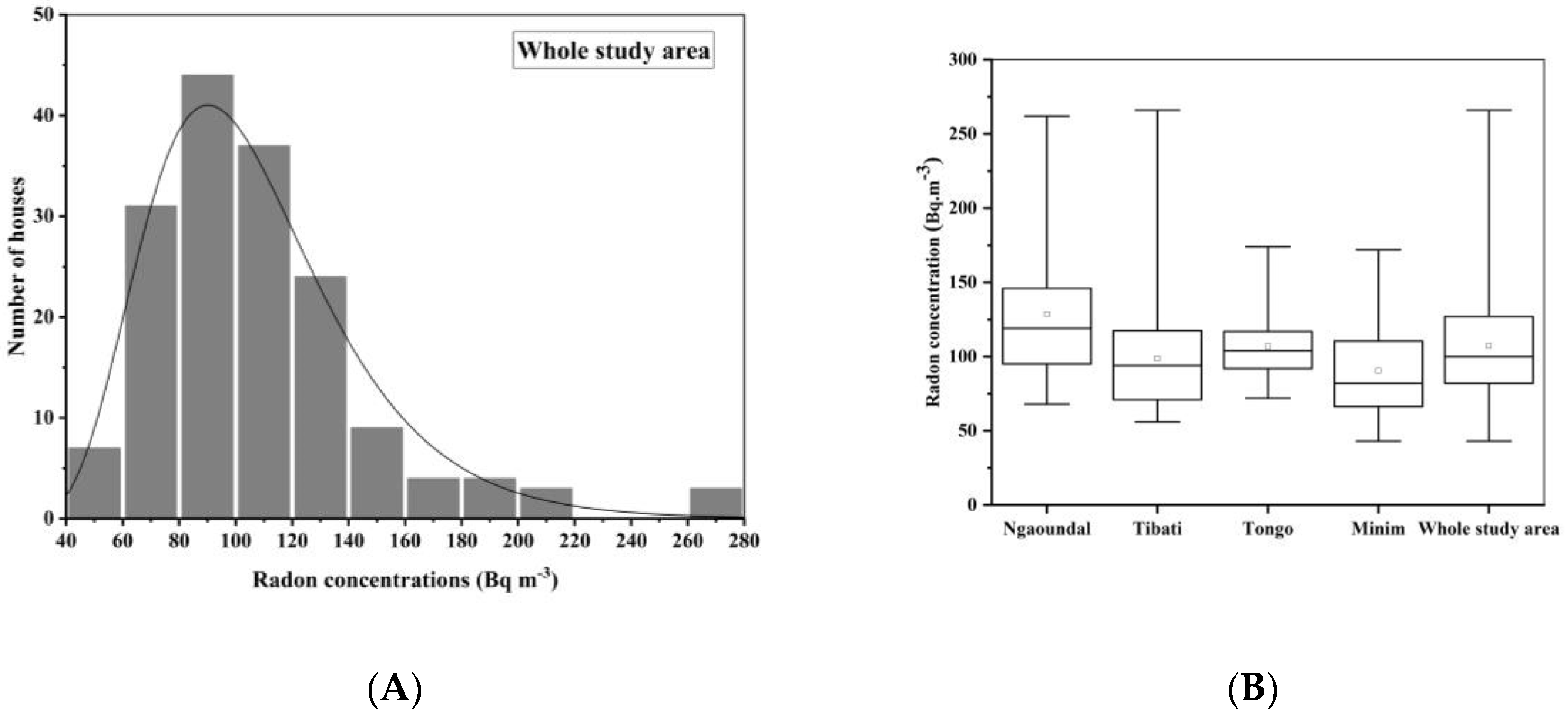
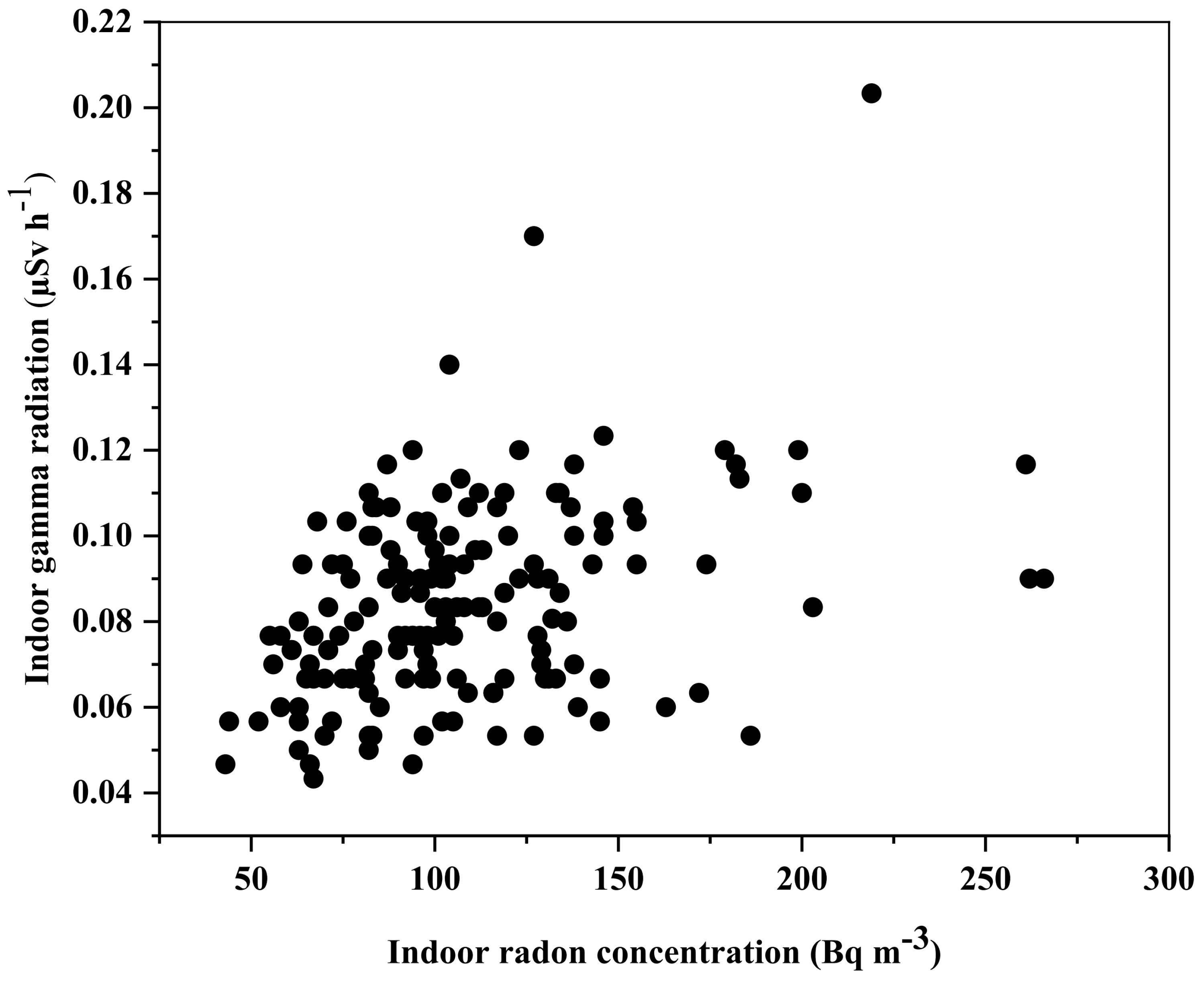
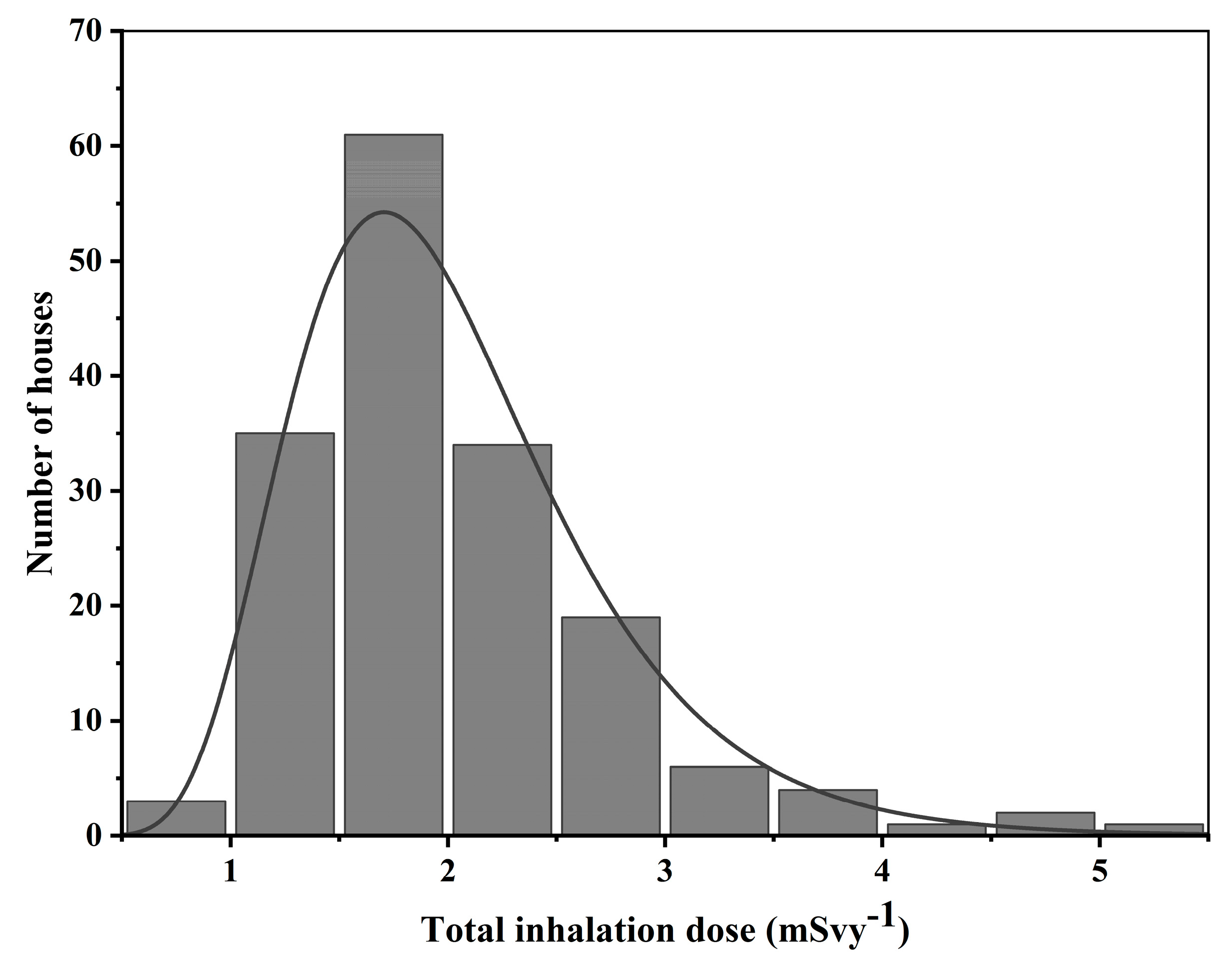
| Statistical Parameters | Radon Concentration (Bq m−3) | ||||
|---|---|---|---|---|---|
| Ngaoundal | Tibati | Tongo | Minim | Whole Study Area | |
| Range | 68–262 | 56–270 | 72–174 | 43–172 | 43–270 |
| AM ± SD | 131 ± 25 | 99 ± 21 | 107 ± 22 | 91 ± 19 | 108 ± 22 |
| GM ± GSD | 123 ± 24 | 93 ± 20 | 105 ± 21 | 85 ± 18 | 102 ± 21 |
| Median | 123 | 94 | 104 | 82 | 100 |
| N | 48 | 56 | 31 | 32 | 167 |
| 222Rn Concentration (Bq m−3) by EPERM | 222Rn Concentration (Bq m−3) by RADTRAK | Type | Ratio (RADTRAK/EPERM | Z-Score |
|---|---|---|---|---|
| 36 ± 8 | 43 ± 12 | Minimum | 0.80 | −0.48 |
| 687 ± 35 | 270 ± 40 | Maximum | 2.50 | 7.8 |
| 233 ± 20 | 108 ± 22 | Arithmetic mean | 2.20 | 4.23 |
| 175 ± 16 | 101 ± 21 | Geometric mean | 1.70 | 2.8 |
| Statistical Parameters | External Effective Dose (mSv) | Inhalation Dose (mSv) | |||
|---|---|---|---|---|---|
| Outdoor (Out) | Indoor (In) | Total Dose (Out + In) | |||
| Ngaoundal | Range | 0.20–0.70 | 0.39–1.07 | 0.64–1.77 | 1.29–4.96 |
| AM ± SD | 0.31 ± 0.08 | 0.56 ± 0.12 | 0.86 ± 0.18 | 2.43 ± 0.87 | |
| GM(GSD) | 0.30 ± 1.24 | 0.54 ± 1.20 | 0.85 ± 1.18 | 2.30 ± 1.38 | |
| Median | 0.30 | 0.53 | 0.82 | 2.26 | |
| N | 48 | 48 | 48 | 48 | |
| Tibati | Range | 0.18–0.30 | 0.28–0.54 | 0.50–0.84 | 1.06–5.04 |
| AM ± SD | 0.23 ± 0.03 | 0.39 ± 0.05 | 0.62 ± 0.06 | 1.87 ± 0.72 | |
| GM(GSD) | 0.23 ± 1.14 | 0.39 ± 1.14 | 0.62 ± 1.12 | 1.77 ± 1.39 | |
| Median | 0.23 | 0.38 | 0.62 | 1.78 | |
| N | 56 | 56 | 56 | 56 | |
| Tongo | Range | 0.21–0.35 | 0.35–0.63 | 0.63–0.94 | 1.36–3.30 |
| AM ± SD | 0.27 ± 0.03 | 0.50 ± 0.07 | 0.77 ± 0.08 | 2.03 ± 0.40 | |
| GM(GSD) | 0.27 ± 1.13 | 0.49 ± 1.16 | 0.77 ± 1.10 | 1.99 ± 1.21 | |
| Median | 0.28 | 0.49 | 0.78 | 1.97 | |
| N | 31 | 31 | 31 | 31 | |
| Minim | Range | 0.07–0.26 | 0.23–0.44 | 0.30–0.68 | 0.81–3.26 |
| AM ± SD | 0.17 ± 0.03 | 0.31 ± 0.05 | 0.48 ± 0.07 | 1.72 ± 0.62 | |
| GM(GSD) | 0.17 ± 1.26 | 0.31 ± 1.16 | 0.48 ± 1.17 | 1.62 ± 1.43 | |
| Median | 0.18 | 0.30 | 0.48 | 1.55 | |
| N | 32 | 32 | 32 | 32 | |
| Whole study area | Range | 0.07–0.70 | 0.23–1.70 | 0.30–1.77 | 0.81–5.04 |
| AM ± SD | 0.25 ± 0.07 | 0.44 ± 0.11 | 0.70 ± 0.18 | 2.03 ± 0.75 | |
| GM(GSD) | 0.24 ± 1.32 | 0.43 ± 1.30 | 0.67 ± 1.28 | 1.92 ± 1.40 | |
| Median | 0.25 | 0.43 | 0.68 | 1.90 | |
| N | 166 | 166 | 166 | 166 | |
© 2020 by the authors. Licensee MDPI, Basel, Switzerland. This article is an open access article distributed under the terms and conditions of the Creative Commons Attribution (CC BY) license (http://creativecommons.org/licenses/by/4.0/).
Share and Cite
Saïdou; Modibo, O.B.; Joseph Emmanuel, N.N.I.; German, O.; Michaux, K.N.; Abba, H.Y. Indoor Radon Measurements Using Radon Track Detectors and Electret Ionization Chambers in the Bauxite-Bearing Areas of Southern Adamawa, Cameroon. Int. J. Environ. Res. Public Health 2020, 17, 6776. https://doi.org/10.3390/ijerph17186776
Saïdou, Modibo OB, Joseph Emmanuel NNI, German O, Michaux KN, Abba HY. Indoor Radon Measurements Using Radon Track Detectors and Electret Ionization Chambers in the Bauxite-Bearing Areas of Southern Adamawa, Cameroon. International Journal of Environmental Research and Public Health. 2020; 17(18):6776. https://doi.org/10.3390/ijerph17186776
Chicago/Turabian StyleSaïdou, Oumar Bobbo Modibo, Ndjana Nkoulou II Joseph Emmanuel, Olga German, Kountchou Noube Michaux, and Hamadou Yerima Abba. 2020. "Indoor Radon Measurements Using Radon Track Detectors and Electret Ionization Chambers in the Bauxite-Bearing Areas of Southern Adamawa, Cameroon" International Journal of Environmental Research and Public Health 17, no. 18: 6776. https://doi.org/10.3390/ijerph17186776
APA StyleSaïdou, Modibo, O. B., Joseph Emmanuel, N. N. I., German, O., Michaux, K. N., & Abba, H. Y. (2020). Indoor Radon Measurements Using Radon Track Detectors and Electret Ionization Chambers in the Bauxite-Bearing Areas of Southern Adamawa, Cameroon. International Journal of Environmental Research and Public Health, 17(18), 6776. https://doi.org/10.3390/ijerph17186776





